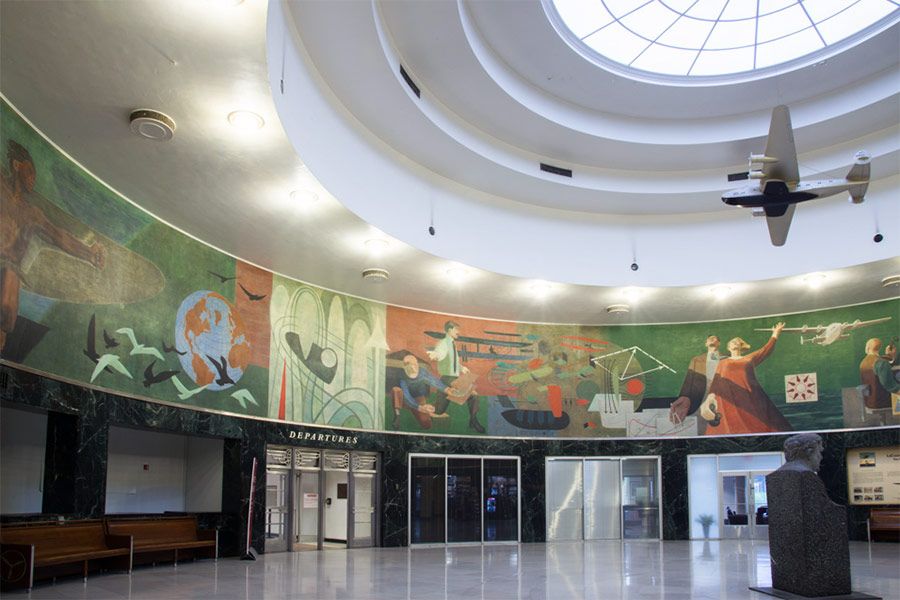Edward Gunts and James Russiello report for The Architect’s Newspaper: A Landmark Anniversary. Architectural preservation commissions across the country are turning 50.

The Museum of the City of New York will present an exhibit entitled Saving Place: 50 Years of New York City Landmarks, starting April 21, 2015. Co-curators are Donald Albrecht, the museum’s Curator of Architecture and Design, and Andrew Dolkart, Director of the Historic Preservation Program at Columbia University. Curator Seri Worden, who runs the James Marston Fitch Charitable Foundation, provided additional support.
On March 6, 2015, The New York School of Interior Design will open Rescued, Restored, Reimagined: New York’s Landmark Interiors, an exhibit focusing on spaces that have been designated interior landmarks.
The New York Transit Museum is mounting an exhibit on landmarks of transportation to be held in Grand Central Terminal. It is curated by Anthony Robins, author of Grand Central Terminal: 100 Years of a New York Landmark.
Currently on view at the Sidney Mishkin Gallery at Baruch College is an exhibit entitled The Landmarks of New York.
New York School of interior Designs’ Rescued, Restored, Reimagined exhibit includes the Customs House, Collections Room.
Organizers of these commemorative events and exhibits say the 50th anniversary of New York’s Landmarks Law—signed by mayor Robert F. Wagner on April 19, 1965—is an ideal time to reflect on how it has changed the city and set an example for others. Many consider the law’s passage and the formation of the preservation commission to be key factors in New York’s rebirth in recent decades. Today, according to the commission, there are more than 31,000 landmark properties in New York City, and most of them are located in 111 historic districts and 20 historic district extensions in all five boroughs. The number of protected sites also includes 1,338 individual landmarks, 117 interior landmarks, and 10 scenic landmarks.
Fifty is “a nice big number,” said Robins. “This is a great moment to get people’s attention. It’s a good excuse to stop and think and look back and see what 50 years of the landmarks law have given to New York and get ready to move forward to the next century.”
Robins said New York’s preservation commission is the only city agency that he can think of where property owners “band together and demand to be regulated.” He said he believes all the Landmarks50 celebrations will be worth it if it reminds people they still need to be vigilant and insist that historic places are protected. “You can’t take anything for granted,” he said. “If you don’t keep up the pressure, it could go away.”
The 50-year mark is also significant because that is the age when buildings are considered historic by one key federal standard. Under the guidelines of the National Register of Historic Places, the federally sanctioned roster of historic sites compiled by the National Park Service, buildings must be at least 50 years old before they can be considered for listing, although exceptions can be made.
Still more preservation panels will pass the 50 year mark over the next few years. The Commission of Architectural Review in Richmond, Virginia, will turn 50 in 2017. San Francisco got its Historic Preservation Advisory Board in 1967. The Commission on Chicago Landmarks came about in 1968. In Florida, the Historic St. Augustine Preservation Board was launched in 1968 and the city’s Historical Architectural Review Board started in 1974. Annapolis’ Historical Preservation Commission, formed in 1953, got regulatory powers in 1969. Panels in Lowell, Massachusetts and Savannah, Georgia, started in 1973.
In some cases, citywide preservation panels replaced or absorbed commissions that were formed earlier to protect smaller districts within the city. In most cases, public preservation commissions have powers to recommend that individual buildings, sites, objects, and districts be designated to receive landmark protection and then to review and approve proposed changes to designated buildings or districts. For that reason, they are often seen as the first line of defense in protecting historic buildings from demolition or defacement. A few boards have begun to designate interiors as well as exteriors.
Preservation commissions have varying degrees of authority to prevent demolitions and designate landmarks. Some are advisory to the city’s mayor or other city agencies, such as the city council, or only have temporary powers to block demolition. Some cannot nominate a building for landmark designation if the owner objects. Chicago’s preservation commission drew widespread criticism over the past year for failing to prevent demolition of Bertrand Goldberg’s Prentice Women’s Hospital, despite pleas from many architects and other design experts that the building was architecturally significant.
Most of the country’s preservation commissions were created after the preservation controversies and losses of the mid 1960s and passage of the National Historic Preservation Act in 1966, though there are many that are older. Charleston, South Carolina, has the country’s oldest citywide preservation commission. It started in 1920. The Vieux Carré Commission in New Orleans, created to protect the French Quarter, was established as an advisory board in 1925 and gained regulatory powers in 1937. The preservation board in San Antonio, Texas, began in 1939. Philadelphia’s Historical Commission will turn 60 in 2015. Baltimore’s Commission for Historical and Architectural Preservation turned 50 this year.
According to the National Trust, approximately 500 towns and cities in America had preservation commissions as of 1978. The number grew to 1,000 by the late 1980s, 2,000 by the end of the 90s. There are more than more than 2,300 today.




